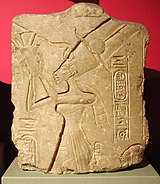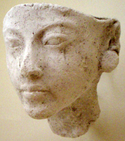
Co-Regent of upper and lower Egipt together with Echnaton at the time of the biggest revolution in the ancient egypt 1370 BCE – ca. 1330 BCE
Nefertiti was the Great Royal Wife of the Egyptian Pharaoh Akhenaten. Nefertiti and her husband were known for a religious revolution, in which they worshiped one god only, Aten, or the sun disc.
After Akhenaten death, Nefertiti ruled briefly as Pharaoh Smenkhkare.
Nefertiti (Beauty of Aten, the Beautiful one has come) is best known by the bust in limestone and gypsum, which is exhibited in the Egyptian Museum in Berlin. The name bears the title of Great Royal Wife and mistress of the Two Lands.
In the grave of Akhenaten she appears as mistress of Upper and Lower Egypt.
After the death of Akhenaten Nefertiti rules as pharao Semenchkare.
when? ca. 1370 BC – ca. 1330 BC ......................where? Armarna in ancient egipt

During the early years in Thebes Akhenaten (still known as Amenhotep IV) had several temples erected at Karnak. One of the structures, the Mansion of the Benben, was dedicated to Nefertiti. In scenes found on the talatat Nefertiti appears almost twice as often as her husband. She is shown appearing behind her husband the Pharaoh in offering scenes in the role of the queen supporting her husband, but she is also depicted in scenes that would have normally been the prerogative of the king. She is shown smiting the enemy, and captive enemies decorate her throne.
In the fourth year of his reign Amenhotep IV decided to move the capital to Akhetaten (modern Amarna). In his fifth year, Amenhotep IV officially changed his name to Akhenaten, and Nefertiti was henceforth known as Neferneferuaten-Nefertiti. The name change was a sign of the ever-increasing importance of the cult of the Aten. It changed Egypt's religion from a polytheistic religion to a religion which may have been better described as amonolatry (the depiction of a single god as an object for worship) or henotheism (one god, who is not the only god).
The boundary stelae of years 4 and 5 mark the boundaries of the new city and suggest that the move to the new city of Akhetaten occurred around that time. The new city contained several large open-air temples dedicated to the Aten. Nefertiti and her family would have resided in the Great Royal Palacein the center of the city and possibly at the Northern Palace as well. Nefertiti and the rest of the royal family feature prominently in the scenes at the palaces and in the tombs of the nobles.
Death

Nefertiti's place as an icon in popular culture is secure as she has become somewhat of a celebrity. After Cleopatra she is the second most famous "Queen" of Ancient Egypt in the Western imagination.

